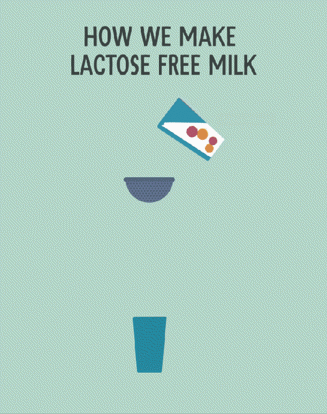
There's no need to avoid dairy if you are lactose intolerant. In lactose free products, we have split the lactose into smaller molecules that you can digest. Here's how.
If you are lactose intolerant, you might enjoy lactose free milk, lactose free yogurt or other lactose free dairy products that are produced in a special way to help you digest dairy without stomach pains.
Firstly, a short explanation of what causes lactose intolerance.
Lactose is a sugar molecule that is naturally present in milk. For you to digest lactose, you need an enzyme in your body called lactase, which can split lactose into two smaller molecules: glucose and galactose. The smaller molecules can then individually be absorbed in the small intestine with no discomfort.
If you have low levels of lactase, the split of the lactose molecule doesn’t take place before it hits the large intestine, where gut bacteria will start to break it down. As side effect of the bacteria’s process, some people get unpleasant symptoms such as stomach pain or bloating.
LINK: Read more about the symptoms of lactose intolerance
Some people with lactose intolerance can consume more dairy before experiencing symptoms while others can consume very little. Sometimes it’s a permanent condition, sometimes it’s only temporary.
How does lactose free dairy work?
But you don’t have to stop drinking milk or eating dairy if you are lactose intolerant. There are more and more lactose free milk and dairy products available in the supermarkets. Arla's produces lactose free milk, lactose free cheese, lactose free yogurts, lactose free butter and spreads and lactose free cream. Which products you can get and what brands they are sold under varies from country to country. For example, in the UK, our lactose free milk is sold under the brand Arla Lactofree.
In lactose free products, we have split the lactose into glucose and galactose for you. At most dairies we use technologies to first pass the milk through filters that remove 40% of the lactose. Next, we remove the remaining lactose by adding the enzyme lactase that can separate the two molecules.
Lactose is a sugar molecule, and as a consequence of the filtering process, the level of carbohydrates is slightly reduced. The level of for example calcium and protein is roughly the same.

Read more about milk nutrition.
Organic lactose free milk
In some countries, Arla offers organic lactose free milk. The organic lactose free milk is made the same way as standard lactose free milk, only based on organic milk from organic farms that comply fully with controlled organic standards
See example of our organic lactose free milk and dairy range:
Does butter, yogurt and cheese have lactose?
Some dairy products are naturally low in lactose. This is because some of the lactose is drained from the product or used by lactic acid bacteria during the fermentation process. Some people with lactose intolerance are able to digest these products without problems.
Lactose in butter and cream
Butter is made from churned cream and contains very little lactose. Regular cream contains some lactose.
Arla offers lactose free cream, for example as part of our UK lactose free range Arla LactoFree.
Lactose in yogurt, skyr and kefir
Some people with lactose intolerance can enjoy fresh yogurt and other fermented products such as skyr or kefir without problems. One reason might be due to the live cultures of lactic acid bacteria that are added to ferment these products.
Arla offers lactose free yogurt and other fermented products. Read more about our UK lactose free yogurt range.

Lactose in cheese
People with lactose intolerance can enjoy the large variety of hard or semi-hard yellow cheeses such as Cheddar, Havarti, Gouda or Emmental. Because of the way that these cheeses are produced, most of the milk water (whey) that contains the lactose is drained from the milk and the lactic acid bacteria that is added digests most of the remaining lactose. This makes many hard or semi-hard yellow cheeses practically lactose free with less than 0,05 grams of lactose per 100 grams of cheese.
However, the level varies in the different cheese types. Hard, aged cheeses often have the lowest amount of lactose. Cream and mould cheeses, cheese spreads, cottage cheese and mozzarella tend to have higher levels of lactose, however still lower than regular liquid milk.
Read more about our lactose free cheese range in the UK.